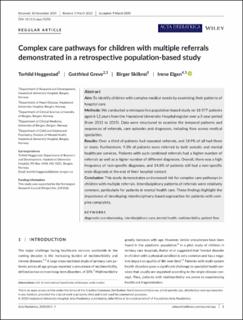Complex care pathways for children with multiple referrals demonstrated in a retrospective population-based study
Journal article, Peer reviewed
Published version

Åpne
Permanent lenke
https://hdl.handle.net/11250/2739954Utgivelsesdato
2020Metadata
Vis full innførselSamlinger
- Department of Clinical Medicine [2066]
- Registrations from Cristin [9791]
Sammendrag
Aim
To identify children with complex medical needs by examining their patterns of hospital care.
Methods
We conducted a retrospective population‐based study on 18 577 patients aged 6‐12 years from the Haukeland University Hospital register over a 3‐year period (from 2013 to 2015). Data were structured to examine the temporal patterns and sequences of referrals, care episodes and diagnoses, including flow across medical specialties.
Results
Over a third of patients had repeated referrals, and 14.9% of all had three or more. Furthermore, 9.3% of patients were referred to both somatic and mental healthcare services. Patients with such combined referrals had a higher number of referrals as well as a higher number of different diagnoses. Overall, there was a high frequency of non‐specific diagnoses, and 34.8% of patients still had a non‐specific main diagnosis at the end of their hospital contact.
Conclusion
This study demonstrates an increased risk for complex care pathways in children with multiple referrals. Interdisciplinary patterns of referrals were relatively common, particularly for patients in mental health care. These findings highlight the importance of developing interdisciplinary‐based approaches for patients with complex complaints.
